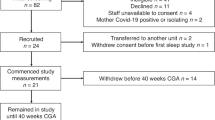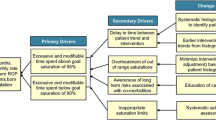Abstract
Objective:
The objective of this study was to compare hand-transcribed oxygen saturation (SpO2) with electronic oximeter data in very low birth weight infants (VLBWI, <1500 g).
Study Design:
Oximeter data were downloaded from birth through 36 weeks postmenstrual age (PMA) for VLBWI before and after interventions to improve neonatal intensive care unit oxygen management. Transcribed SpO2 values were obtained by chart review. Proportions of transcribed and oximetry data in target (85 to 93%), hypoxemic (80 to 84%), and hyperoxemic (⩾98%) ranges before and after intervention were compared.
Result:
There were 30 441 oximetry hours before intervention and 54 538 oximetry hours after intervention. Transcribed SpO2 values correlated strongly with oximeter overall. However, during hours on supplemental oxygen, transcribed values significantly overdocumented target range and underdocumented values 80 to 84 and ⩾98%. This finding varied by respiratory support and PMA, and increased after intervention.
Conclusion:
Transcribed SpO2 values overdocumented target range and underdocumented hyperoxemic and hypoxemic ranges compared with electronic oximeter data. These results support incorporating electronic oximeter data into medical records.
This is a preview of subscription content, access via your institution
Access options
Subscribe to this journal
Receive 12 print issues and online access
$259.00 per year
only $21.58 per issue
Buy this article
- Purchase on Springer Link
- Instant access to full article PDF
Prices may be subject to local taxes which are calculated during checkout


Similar content being viewed by others
References
Fouzas S, Priftis KN, Anthracopoulos MB . Pulse oximetry in pediatric practice. Pediatrics 2011; 128 (4): 740–752.
American Academy of Pediatric and American College of Obstetricians and Gynecologists. Guidelines for Perinatal Care. American Academy of Pediatric and American College of Obstetricians and Gynecologists 2007.
Adhami N, Arabi Y, Raees A, Al-Shimemeri A, Ur-Rahman M, Memish ZA . Effect of corticosteroids on adult varicella pneumonia: Cohort study and literature review. Respirology 2006; 11: 437–441.
Boyle M, Wong J . Prescribing oxygen therapy. An audit of oxygen prescribing practices on medical wards at North Shore Hospital, Auckland, New Zealand. N Z Med J 2006; 119: 1–5.
Taheri P, Abbasi E, Abdeyazdan Z, Fathizadeh N . The effects of a designed program on oxygen saturation and heart rate of premature infants hospitalized in neonatal intensive care unit of Al-Zahra Hospital in Isfahan in 2008–2009. Iran J Nurs Midwifery Res 2010; 15: 66–70.
Sink DW, Thomas P, Bober B, Hagadorn JI . Forty Percent Achievement of the Oxygen Saturation (SpO2) Target Range 85–93% is Associated with Improved Retinopathy of Prematurity Outcomes. Pediatric Academic Societies: Vancouver, Canada, 2010 E-PAS20104420.502; E-PAS20104420.502.
Zar J . Biostatistical Analysis 3rd edn Prentice-Hall: Upper Saddle River, NJ, USA, 1996.
Carlo WA, Finer NN, Walsh MC, Rich W, Gantz MG, Laptook AR et al. Target ranges of oxygen saturation in extremely preterm infants. N Engl J Med 2010; 362 (21): 1959–1969.
Stenson BJ, Tarnow-Mordi WO, Darlow BA, Simes J, Juszczak E, Askie L et al. Oxygen saturation and outcomes in preterm infants. N Engl J Med 2013; 368 (22): 2094–2104.
Schmidt B, Whyte RK, Asztalos EV, Moddemann D, Poets C, Rabi Y et al. Effects of targeting higher vs lower arterial oxygen saturations on death or disability in extremely preterm infants: a randomized clinical trial. JAMA 2013; 309 (20): 2111–2120.
Polin RA, Bateman D . Oxygen-saturation targets in preterm infants. N Engl J Med 2013; 368 (22): 2141–2142.
Bancalari E, Claure N . Oxygenation targets and outcomes in premature infants. JAMA 2013; 309 (20): 2161–2162.
Ottens J, Baker RA, Newland RF, Mazzone A . The future of the perfusion record: automated data collection vs. manual recording. J Extra Corpor Technol 2005; 37 (4): 355–359.
Ahmed SR, Finer NN . The effect of averaging time on oximetry values in the premature infant. Pediatrics 2010; 125: e115–e121.
Johnston E, Boyle B, Juszczak E, King A, Brocklehurst P, Stenson B . Oxygen targeting in preterm infants using the Masimo SET Radical pulse oximeter. Arch Dis Child Fetal Neonatal Ed 2011; 96: F429–F433.
Eastwood GM, O'Connell B, Considine J . Low-flow oxygen therapy in intensive care: an observational study. Austr Crit Care 2011; 24: 269–278.
Devitt JH, Rapanos T, Kurrek M, Cohen MM, Shaw M . The anesthetic record: accuracy and complete-ness. Canad J Anaesth 1999; 46 (2): 122–128.
Acknowledgements
No external funding was secured for this study.
Author information
Authors and Affiliations
Corresponding author
Ethics declarations
Competing interests
The authors declare no conflict of interest.
Rights and permissions
About this article
Cite this article
Ruiz, T., Trzaski, J., Sink, D. et al. Transcribed oxygen saturation vs oximeter recordings in very low birth weight infants. J Perinatol 34, 130–135 (2014). https://doi.org/10.1038/jp.2013.157
Received:
Revised:
Accepted:
Published:
Issue Date:
DOI: https://doi.org/10.1038/jp.2013.157
Keywords
This article is cited by
-
Histogram analysis for bedside respiratory monitoring in not critically ill preterm neonates: a proposal for a new way to look at the monitoring data
European Journal of Pediatrics (2021)
-
Continuous vital sign analysis for predicting and preventing neonatal diseases in the twenty-first century: big data to the forefront
Pediatric Research (2020)
-
Commentary on “Oxygen desaturations in the early neonatal period predict development of bronchopulmonary dysplasia” by Fairchild et al.
Pediatric Research (2019)
-
Alarm safety and oxygen saturation targets in the Vermont Oxford Network iNICQ 2015 collaborative
Journal of Perinatology (2017)



